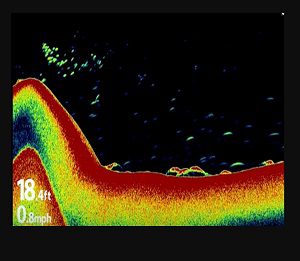 Fishing depends not only on luck but also on technology and experience; you can get yourself in a favorable position to catch many fishes. Most anglers prefer the hard bottom due to higher chances of sight-oriented fishes that can see and attract the bait. The hard bottom also has higher oxygen content, providing better chances of catching bigger and heavier fishes. You can also find crayfish and minnows that hide in the rocks. Seeing the hard bottom is not too difficult with the help of a fish finder, and in this article, we are going to learn how to do that.
Fishing depends not only on luck but also on technology and experience; you can get yourself in a favorable position to catch many fishes. Most anglers prefer the hard bottom due to higher chances of sight-oriented fishes that can see and attract the bait. The hard bottom also has higher oxygen content, providing better chances of catching bigger and heavier fishes. You can also find crayfish and minnows that hide in the rocks. Seeing the hard bottom is not too difficult with the help of a fish finder, and in this article, we are going to learn how to do that.
How Find Hard Bottom On Fish Finder?
If you do the fishing by going into the lake or river on a boat, there are high chances of having a fish finder. The technology uses powerful sonar units to detect what is below the surface. For most anglers, it is just an instrument by which they determine the lake’s depth or the river, but it can tell you a lot more than that and can help you locate and catch fish.
The nature of the bottom is essential because most fish prefer the hard bottom. Sometimes, it is better to look for the transition zone because they can offer a wide variety of fish in tremendous quantities. But how are you going to find what is beneath you? First, lets’ understand the principle of the fish finder that is based upon the Sonar. The Sonar sends out the sound signal and measures its strength upon its return. In this way, the structure of the bottom is plotted. If the bottom surface is soft, most of the sonar signal would be dissipated or absorbed by the cover. On the other hand, the hard bottom will reflect most of the movement, and the screen shows vital signal feedback.
So in simple terms, the hard surface will produce a strong signal, and the soft texture will produce the weak signal shown on the screen.
Down And Side-Imaging
These are the standard displays in the Sonar and use a single color array in the variable shades to define the bottom. The simple understanding is that the brighter the screen is, the stronger the signal is, and eventually, the hard bottom there is. Weak singles are shown in darker shades and may even look completely black in the side imaging technology. If you are looking for the hard bottom, look for the lighter spots and if you are looking for transition zones, look for contrast. When you are on a rigid base, you may be able to see some more rigid objects, such as the strong return of the rocks, fishes, and logs.
Traditional 2D Sonar
Newer models of the fish finder work on the different color grid patterns to better identify the signal strength. Unlike the older black and white models that are highly inaccurate and show only one shade of color, they have three different color ranges to specify the signal strength. Moreover you look more visible, accurate and strong signal return /
The color combinations of newer models are usually red, green, and yellow. Red color means the strongest signal, yellow means moderate signal strength, and the green represents a weak signal. It can be remembered easily by understanding the heat. High heat is red, then yellow, and finally green. In the color display, the width of the color band is also essential. The hard bottom will be shown as a red color with a defined width, spread like a line. While the soft band may show the red color at some points, it is not distinct and has a mixture of other colors.
Conclusion
Experienced anglers prefer to know the bottom underneath them when going fishing. It is better when combined with the time of the year and the type of fish you are trying to catch to have a better chance of catching them. Choosing the hard bottom is preferred because there are better chances of sight-oriented fishes that hunt their prey by seeing them.
- What Do You Need for Fishing - August 18, 2022
- How to Find Offshore Fishing Spots - August 18, 2022
- What to Use for Trout Fishing - August 17, 2022
